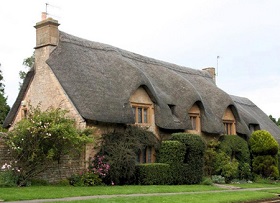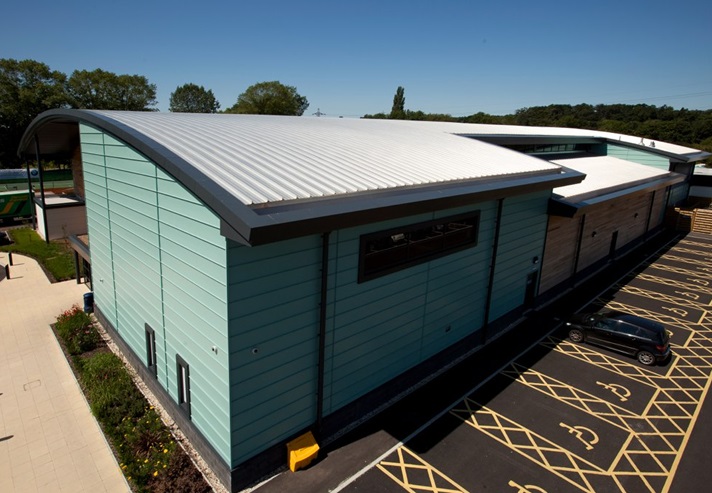Types of roof

|

|

|
Approved document C: Site preparation and resistance to contaminants and moisture, 2004 edition incorporating 2010 and 2013 amendments defines a roof as: ‘Any part of the external envelope of a building that is at an angle of less than 70° to the horizontal.’
A roof is a structure forming the upper covering of a building or other shelter. Its primary purpose is generally to provide protection from the elements, but it may also contribute to safety, security, privacy, insulation, and so on.
Roofs may have openings or windows within them to allow light into buildings, as well as providing, access, ventilation, views, and so on. They also frequently include other features such as chimneys, communications infrastructure, building services, drainage, lighting, access routes, and so on.
Roofs can be constructed from a wide variety of materials and in a wide variety of shapes depending on the requirements they have to satisfy, the local climate, the availability of materials and skills, the span to be covered, and so on.
This article provides links to further information about a range of roof types.
Click on the links below to access more information:
- Blue roof.
- Brown roof.
- Butterfly roof.
- Canopy.
- Clipped gable roof.
- Closed couple roof.
- Cold roof.
- Collar roof.
- Conical roof slating.
- Cool roof.
- Couple roof.
- Crow-stepped gable.
- Cross hip roof.
- Curb roof.
- Dome.
- Domestic roof.
- Dutch gable.
- Fabric roof.
- Flat roof.
- Fly roof (flying roof)
- Gambrel roof.
- Gable roof.
- Geodesic.
- Green roof.
- Half gable roof.
- Hammerbeam roof.
- Hip roof.
- Hyperbolic paraboloid.
- Jerkinhead roof.
- Lean-to roof.
- Long span roof.
- Metal roofing.
- Mansard roof.
- Mono pitch roof.
- Pitched roof.
- Purlin roof.
- Saltbox roof.
- Saw-tooth roof.
- Shell roof.
- Shingle roofing.
- Skillion roof
- Slate roofing.
- Tile roofing.
- Thatch roofing.
- Valley roof.
- Vault.
- Warm roof.
Featured articles and news
Building Safety Regulator reforms
New roles, new staff and a new fast track service pave the way for a single construction regulator.
Cooling centres and cool spaces
Managing extreme heat in cities by directing the public to places for heat stress relief and water sources.
Winter gardens: A brief history and warm variations
Extending the season with glass in different forms and terms.
Restoring Great Yarmouth's Winter Gardens
Transforming one of the least sustainable constructions imaginable.
Construction Skills Mission Board launch sector drive
Newly formed government and industry collaboration set strategy for recruiting an additional 100,000 construction workers a year.
New Architects Code comes into effect in September 2025
ARB Architects Code of Conduct and Practice available with ongoing consultation regarding guidance.
Welsh Skills Body (Medr) launches ambitious plan
The new skills body brings together funding and regulation of tertiary education and research for the devolved nation.
Paul Gandy FCIOB announced as next CIOB President
Former Tilbury Douglas CEO takes helm.
UK Infrastructure: A 10 Year Strategy. In brief with reactions
With the National Infrastructure and Service Transformation Authority (NISTA).
Ebenezer Howard: inventor of the garden city. Book review.
The Grenfell Tower fire, eight years on
A time to pause and reflect as Dubai tower block fire reported just before anniversary.
Airtightness Topic Guide BSRIA TG 27/2025
Explaining the basics of airtightness, what it is, why it's important, when it's required and how it's carried out.
Construction contract awards hit lowest point of 2025
Plummeting for second consecutive month, intensifying concerns for housing and infrastructure goals.
Understanding Mental Health in the Built Environment 2025
Examining the state of mental health in construction, shedding light on levels of stress, anxiety and depression.
The benefits of engaging with insulation manufacturers
When considering ground floor constructions.
Lighting Industry endorses Blueprint for Electrification
The Lighting Industry Association fully supports the ECA Blueprint as a timely, urgent call to action.






















Comments